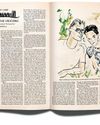Prøve GULL - Gratis
FOR ART'S SAKE
The New Yorker
|October 20, 2025
"Blue Moon" and "Nouvelle Vague."

Leave it to Richard Linklater to see how, in art, the fundamental things apply. In his two new movies—“Blue Moon,” about the lyricist Lorenz Hart, and “Nouvelle Vague,” about the director Jean-Luc Godard’s making of “Breathless”—the central conflicts involve time. Linklater has made two dozen features in a career now in its fourth decade; having learned to work the clock, he finds pathos in the idea of two artists at risk of being late. “Blue Moon” and “Nouvelle Vague” are being released two weeks apart (on October 17th and 31st, respectively), a happy accident highlighting their connections in Linklater’s cinematic universe.
“Blue Moon” is set in New York, mainly in the bar at Sardi’s, on March 31, 1943—the night of the première of “Oklahoma!,” the musical that Hart’s longtime collaborator, the composer Richard Rodgers, created with another writer, Oscar Hammerstein II. Hart (Ethan Hawke)—let’s call him Larry, as people do in the movie, to distinguish the character from the real-life Hart—walks out on the show’s title number and takes refuge at the bar. He’s bitter and jealous, aware that the show will be a big hit and that he could never have written it. But he’s nonetheless sincere when venting to the bartender, Eddie (Bobby Cannavale), that it’s sentimental and phony, and that this artificial sweetness is crucial to its success.
Denne historien er fra October 20, 2025-utgaven av The New Yorker.
Abonner på Magzter GOLD for å få tilgang til tusenvis av kuraterte premiumhistorier og over 9000 magasiner og aviser.
Allerede abonnent? Logg på
FLERE HISTORIER FRA The New Yorker

The New Yorker
THE TALK OF THE TOWN
The militarization of American cities, including Los Angeles, Portland, and Chicago, has brought home a perverse irony. T
4 mins
October 20, 2025

The New Yorker
THIS IS MISS LANG
The brief life and forgotten legacy of a remarkable American poet.
19 mins
October 20, 2025

The New Yorker
RAMBLING MAN
Peter Matthiessen's quest to escape himself—at any cost.
15 mins
October 20, 2025

The New Yorker
DEGREES OF HOSTILITY
How far will the Administration's assault on colleges and universities go?
26 mins
October 20, 2025

The New Yorker
GOINGS ON
What we're watching, listening to, and doing this week.
6 mins
October 20, 2025

The New Yorker
READY OR NOT
Zohran Mamdani wants to transform New York City. Will the city let him?
37 mins
October 20, 2025

The New Yorker
Alexandra Schwartz on Joan Acocella's "The Frog and the Crocodile"
When I am stuck on a sentence or trying to wrestle an idea into shape, I turn to Joan Acocella.
3 mins
October 20, 2025

The New Yorker
A BROTHER'S CONVICTION
Did a grieving man's quest for justice go too far?
43 mins
October 20, 2025

The New Yorker
THE KEY TO ALL MYTHOLOGIES
Why the quest for a master code goes on.
13 mins
October 20, 2025

The New Yorker
FOR ART'S SAKE
\"Blue Moon\" and \"Nouvelle Vague.\"
6 mins
October 20, 2025
Listen
Translate
Change font size
